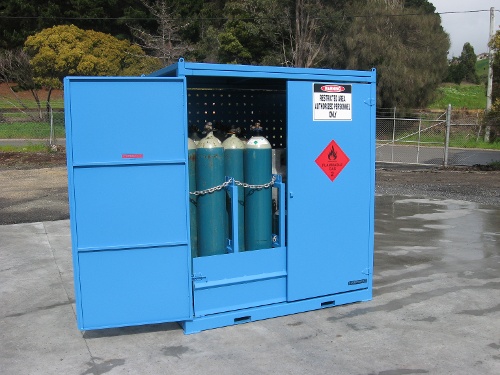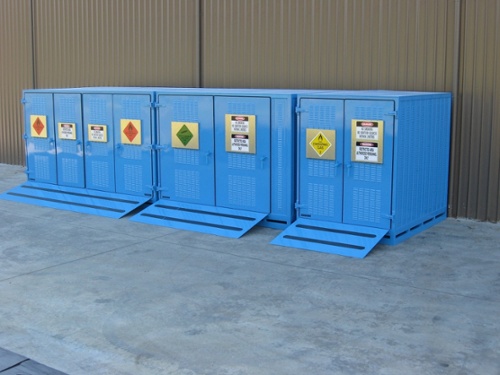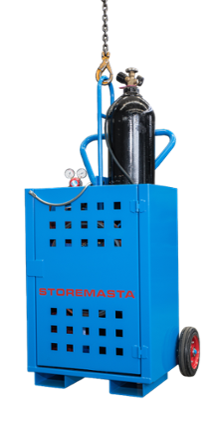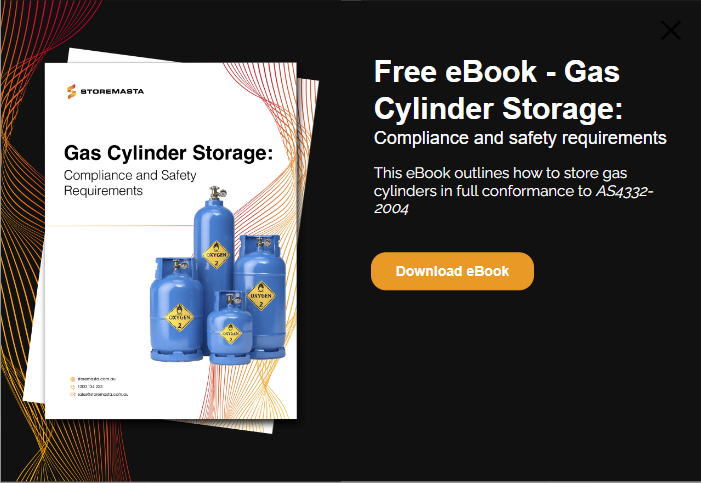Compressed gases stored at high pressure in cylinders, present significant dangers and hazards to workplaces all over Australia. This blog looks at gas bottle safety: how to store cylinders safely as well as handling tips specified by AS 4332 - The storage and handling of gases in cylinders.
Gas Bottle Hazards in the Workplace
When it comes to gas bottle safety, there are some key hazards surrounding gas bottles. The dangers of gas cylinders include the health hazards and physiochemical hazards of the gases, as well as the hazards caused by the gas cylinders.
The health and physiochemical hazards associated with gases include:
- Exposure to toxic and corrosive gases (chlorine, ammonia).
- Asphyxiation by inert gases (argon, helium, neon and nitrogen) or other asphyxiants like LPG that deplete oxygen levels in the air.
- Fires and explosions from flammable gases (LPG, methane, butane) that meet an ignition source.
- Dangerously reactive gases (acetylene) that spontaneously combust.
- Cold wounds and frostbite injuries from cryogenic or liquefied gases (nitrogen, LPG).
Gas cylinders present health, physiochemical and physical hazards.
Gas cylinder hazards include:
- Strains, fractures and other manual handling injuries while moving bulky, heavy cylinders.
- The long slim shape of gas cylinders make them unstable. Therefore, they can be easily knocked over.
- Cylinders exposed to heat can cause rupturing or explosions.
- Gas leaks from damaged or worn valves and fittings.
- Accidental rapid release causing fires and explosions — or launching the cylinder into the air like a torpedo.
QUICK TIP: To learn how to manage and control risks when storing gas cylinders at your workplace, download our free eBook Gas Cylinder Storage: Compliance and Safety Requirements.
Safe Storage of Gas Cylinders
For optimum safety and compliance, all gas cylinder stores should meet the requirements of the Australian Standard AS 4332 - The storage and handling of gases in cylinders.
According to this Standard, gas cylinder stores must be:
- Located outdoors, at ground level wherever possible.
- Not be exposed to equipment and machinery that generates heat, as the cylinder may rupture.
- At a site that is clear of vegetation, combustibles and refuse.
- Installed on a solid base that can withstand any type of weather.
- In a location that’s fenced and secured against unauthorised access.
- Naturally ventilated or by a mechanical ventilation system.
- Strictly NO SMOKING.
- Equipped with the safety data sheets (SDS) for each gas cylinder product.
- Separated from any potential ignition sources, such as equipment that can produce flames, heat or sparks. And in the case of flammable gases — fittings or equipment that generate static electricity.
- Correctly signed with safety labels, hazard statements, and placards.
- Equipped with first aid facilities that are installed nearby.
- Free from risk of impact. Use bollards or crash barriers if there is the potential for vehicles to impact your gas bottle store.
All gas cylinder and gas bottle storage should meet the requirements of the Australian Standards.
When loading your gas cylinders into storage, make sure that:
- Cylinders are stored upright and restrained by chains or safety straps.
- Valves are closed, attachments removed, and safety caps in place.
- The store follows the rules of dangerous goods segregation, with flammable gases, toxic gases and oxidising gases sufficiently separated.
- Your staff must treat empty cylinders with the same level of care as full cylinders, separating them from full cylinders into their own (well-marked) storage area.
QUICK TIP: In Australia all compressed gases are classed as Hazardous Chemicals as well as Dangerous Goods. You’ll need to make sure that your gas stores are properly separated from incompatible hazardous chemicals as well as other gas classes identified in AS 4332.
Handling for Gas Bottles
All gas bottles must be handled with care to prevent manual handling injuries as well as damage to the cylinder. Your staff must be properly trained so they understand the dangers of the gases contained in the cylinders, such as liquid petroleum gas (LPG), as well as correct handling procedures.
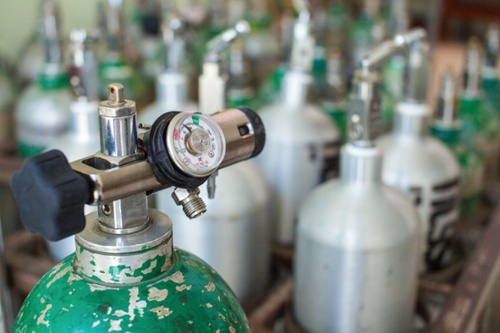
The correct handling of compressed gas in cylinders is essential for site safety.
The following gas bottle handling procedures are essential under the Australian Standard:
- Gas cylinder valves must be closed and safety caps in place when moving cylinders to avoid a dangerous gas leak.
- Gas bottle trolleys, forklifts and other mechanical lifting devices must always be used for moving gas cylinders.
- Precautions should be taken to prevent a gas cylinder from falling or being knocked over. Make sure your staff use only gas bottle trolleys and lifting devices that have individual safety straps or other restraints.
- Never drop or roll cylinders over the side of trucks or from other delivery/storage platforms.
- Don’t apply excessive force to the cylinder valve — eg, using the valve for lifting or carrying.
- Never use a gas or the cylinder for anything outside its real purpose (eg, using cylinders as rollers).
Gas bottle trolleys, like this oxy acetylene trolley, are a handling solution that can reduce risk to people and property.
Training for Gas Cylinder Handling
Additionally, to ensure gas bottle safety in your operations, you must train staff to understand and control the hazards that the gas cylinders present.
You should ensure your procedures and staff training includes the following industry best practices:
- Don’t place objects on cylinders and make sure welding torches and other attachments are removed when not being used.
- Don’t try and catching falling gas cylinders. Let it drop and get to a safe distance. Approach fallen cylinders cautiously checking the valve and regulator for damage.
- Always wear PPE suited to both the gas and gas cylinder type — eg, leather gloves, safety shoes and eye guards.
BEST PRACTICE: Document cylinder safety procedures as well as details of staff inductions and training sessions. Update safety skills and knowledge by providing adequate supervision, regular toolbox talks and safety forums.
Need Some Help with Gas Bottle Safety?
If you need more information about how to store gas bottles at your workplace and comply with WHS legislation and Australian Standards, why not download our free eBook Gas Cylinder Storage: Compliance and Safety Requirements. The eBook is a practical resource for WHS Managers needing clear and actionable advice to manage the risks associated with storing gas cylinders. Download our free gas safety guide to read it today .
Joining the team as a Dangerous Goods Storage Consultant, Melissa Hampton became Storemasta's Marketing Manager in late 2021. With extensive knowledge and experience in chemical compliance, Melissa is responsible for leading the Marketing team and helping shape their marketing strategy. In her spare time, you can find Melissa hiking, swimming and enjoying the great outdoors in beautiful north-west Tasmania.
